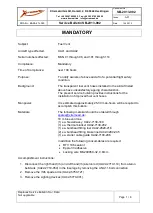
LAUNCHING PROCEDURE
WARNING
Do not stand up on the SUP if there are objects nearby that present a falling
hazard (dock, rocks, etc.).
Remain on your knees and use the paddle to move further away before standing
up. You can return to a kneeling position at any time if a hazardous situation
presents itself.
•
Keep your paddle in hand at all times.
•
Make sure the water is deep enough so that the fin will not scrape the bottom.
•
Start by kneeling in the center and pressing your hands on both sides of the
board for added stability.
•
Stand up one foot at a time (use the paddle for balance).
•
Your feet should be positioned shoulder-width in the middle of the board,
one foot on each-side of the carry handle.
•
When you feel comfortable, start paddling forward.
MOORING/DOCKING
If you want to moor your SUP to a dock, make sure that:
•
It is away from rocks or sharp objects.
•
The water is deep enough to avoid damaging the board.
5
BASIC SUP PRINCIPLES
Learn and practice basic skills on a calm lake. Start slowly in open areas with
few people around. Take your SUP through rougher water only when you are
confident about your abilities.
For maximum comfort, make sure you have a paddle with a length that fits
your size. In general, you should add 8 to 10 inches to your height to determine
the length of the paddle. For example, if you are 5 feet 10 inches (70 inches)
tall, your paddle should be 78-80 inches long.
You should stand in the center of the board when you paddle. In calm water,
your feet should be positioned shoulder-width apart and pointing forward. In
waves or rougher water, you should move a foot towards the back of the board
and assume a surfing position. Practice moving your feet on the board and
changing positions to improve your balance.
The best way to make a quick turn with your board is to move your weight
back. The nose of the board will be out of the water and it will be much easier
to turn.
If you paddle on a large body of water, like a lake or ocean, be sure to use a
leash that connects you to your board. If you fall, your board could be pushed
away from you, leaving you alone in the water.
If you paddle on a river with a strong current, do not use an ankle leash. If
you fall, your board could drag you under the water and carry you down with
the current. Or the leash could get caught on something in the water (rocks,
branches, tree trunks, etc.) and cause you to fall off your board.
Be careful in windy conditions. Your body is completely exposed when standing
up and strong winds can greatly affect your movements and push you off
course. Adopting a kneeling or sitting position when faced with such conditions
can prevent the wind from affecting your course.
Never leave your board if you do not have a leash, even if you lose your
paddle. You can always paddle with your hands, which is an easier option than
trying to swim back. As well, if the wind picks up and you are not on your
board, it can float away faster than you can swim to retrieve it. This is why a
leash is so important.






































